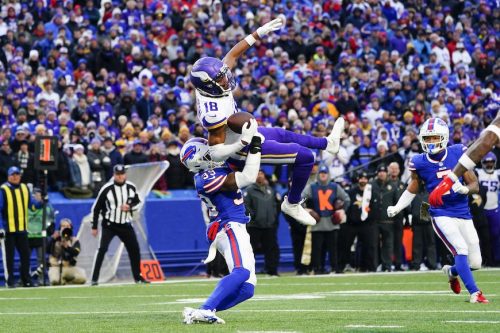By Mark Pattison | Catholic News Service
WASHINGTON (CNS) — My first major assignment as Catholic News Services’ media editor in 1992 — in fact, I was just keeping the seat warm for someone who never returned — was to go to Hollywood for the Television Critics Association’s annual summer “press tour.”
Another fact check: The TV writers don’t go on tour. Instead, the networks, syndicators and cable behemoths take turns occupying spacious hotel ballrooms and paying for fancy spreads and events morning, noon and night. The only touring we’d do is from our room’s floor to the ground floor!
But during that first 10-day trip, some fellow from some network or another whose name is lost to history was talking about demographics. The key was coming up with shows that would draw women. They already knew what men wanted, he added: “Sports, and more sports.”
In 1992, the only prime-time sports on network TV outside of championships or playoffs was “Monday Night Football,” then on ABC. Times have changed in the past 30 years.
There’s still Monday night football, but on ESPN, which — like ABC — is owned by Disney. NBC carries “Sunday Night Football.” College football airs on ABC, and quite often on Fox, on Saturday nights in the fall. And pro football routinely runs over into prime time on Sunday evenings.
The Athletic, a sports news service recently purchased by The New York Times, deduced that of the 100 most-watched programs of the 2021-22 TV season, 75 of them were pro football games. Another six were college football games. No other sport got even one slot in that top-100 list.

The NFL does a fine job of keeping mostly everyone happy. Over-the-air TV watchers will likely get three games from which to choose each Sunday. Fans with cable get the ESPN entry. Households with satellite dishes can fork over some dough to get the NFL’s “Sunday Ticket” package showing nearly every game on some spot in the 500-channel universe.
The league also keeps the four major broadcast networks happy. Fox and CBS get the Sunday slate of games, save for the Sunday carve-out for NBC and the Monday carve-out for ESPN. And more cash fills the NFL’s coffers now that Amazon’s Prime Video has exclusive rights to Thursday night games.
(Other streaming services also are learning that despite their catalogs of thousands of episodes, a single live event can draw lots of viewers. Major League Baseball cut a deal with Apple TV Plus for Friday night games, and with Peacock for Sunday games, with no other big-league games allowed to start for 90 minutes after the first pitch of the Peacock game.)
But that’s not the full story. The Athletic also dug up the history of how things started to get the way they are.
Rewind to 60 years ago. Individual colleges were making separate deals to get their games on the air. But NFL teams — back then, there were only 14 — were cutting their own deals to get airtime. And there was this upstart American Football League that had pooled its TV rights to sell to the highest bidder. The college football folks were concerned about getting overrun by the pro game and sought relief from Congress.
Relief is what they got. Congress allowed the NCAA to pool the gridiron rights of its member schools. It also gave them a fairly exclusive window on Saturdays from the start of September to the middle of December in which to air its games. The NFL and AFL, the latter merging into the former by the end of the 1960s, got the same opportunity to pool rights — and similarly avoid antitrust scrutiny — but on Sundays.
It’s a fairly safe bet that lawmakers had no idea just how much football would grow when backed by these antitrust protections.
But there’s one mold-breaker in every bunch. Notre Dame, one of college football’s few remaining independents but with a storied history dating back to Knute Rockne and George Gipp, made its own deal with NBC — which is otherwise not invested in the college game — to air its home games starting in 1991 for $30 million (it’s more now). Given the payouts Notre Dame can offer to other schools to play a game under the visage of Touchdown Jesus — the Fighting Irish play at least seven home games every year.
Boston College, the other Catholic university playing in the NCAA’s Football Bowl Subdivision, is a member of the Atlantic Coast Conference. It might snag the occasional network spotlight, but there’s always the ACC Network, a cable channel devoted to nothing but ACC sports, highlights and commentary. It’s become the norm for a NCAA Division I conference to have its own channel to add to its revenue stream.
But, if you hadn’t noticed, the college and pro season’s length has stretched out. College conferences play championship games that were unheard-of a generation ago. Then there are the bowl games that fill up ESPN’s December and January schedule. The 32-team NFL now plays 17 regular-season games and has 14 teams in the playoffs. The college football playoff will expand from the current four teams to 12.
The college conferences have been expanding, too, raiding other conference’s members to boost revenues. The Big Ten leapfrogged its geographic boundaries to add UCLA and Southern California, scoring a three-network, seven-year, $7 billion deal. After the Southeastern Conference got commitments from Texas and Oklahoma to join, ESPN was sued, as the plaintiffs claimed the network had assisted in luring them from the Big 12.
Those games are going to have to be played sometime. Already, college teams from leagues not in the so-called “Power Five” play games on Tuesday nights for the exposure. And what about Friday nights? Just as college football feared its audience would dry up if the pros played opposite them on Saturdays, that old high school spirit could wither and fade if classmates, parents and townsfolk keep their eyes glued to the tube to football.






















